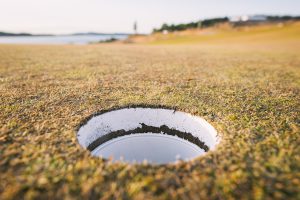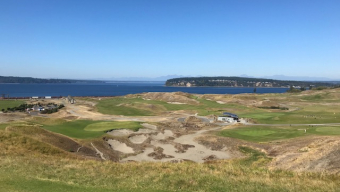UNIVERSITY PLACE – When Chambers Bay golf course was conceived in the early 2000s, built and opened in 2008 and hosted the U.S. Amateur in 2010 and the U.S. Open in 2015, there was and continues to be but one singular focus – the greens.
Nothing else really matters as much. The 7,800-yard length was just fine. The Robert Trent Jones, Jr. layout was laudable. And the view of the Sound was unmatched.
It’s all about the greens, the all-fescue greens, matching the entire course. How would they hold up under the strain of year-round play? How long would it take for the greens to mature? Most importantly, how true would they be, particularly by the time they were under the assault of the greatest golfers in the world at the Open?
The simple answer was, they failed. In hindsight, it was a mistake. On the grand stage, in front the world, they failed. The USGA was primarily responsible, staving those tiny fescue roots from water in the final week buildup to the tournament. The result was spotty putting surfaces on the final Sunday, leading to grousing by the PGA’s finest and perhaps a tainted result – specifically Dustin Johnson’s inexplicable three-putt on the patchy 18th green, denying a Monday playoff with Jordan Spieth, who won on the spot.
Chambers, the $25 million, Pierce-County-owned course that was designed and built with major championships in mind, had blown it. Or at least had it blow up, a lasting legacy that made a second Open less likely. Those professional golfers, the thousands of fans and the USGA officials all departed with concerns about the quality of the course – and whether it could ever hold another major. It took nearly 100 years to get an Open to the Northwest and it seemed it would take 100 for another.

The starved Chambers greens at the 2015 Open not only looked brown and peaked but played inconsistently
But this winter Chambers basically is trying to right the wrong. It’s biting the bullet. No more fescue greens. If you tried to get 18 in right now you won’t get back the first tee. The public course has been shut down to the public – since the end of September – so that all the greens can be converted to poa annua grass surfaces. It might now open again until sometime in March, maybe April.
“When we started to have trouble with (Nos.) 7, 10 and 13, we decided to sod with poa annua. We didn’t have enough sod to do all the greens at that time,” said longtime Chambers Bay general manager Matt Allen.
Those three greens, now mature after a couple growth years, are splendid. They have filled out. They hold an approach shot. They have true rolls. They are the harbingers for the other 15.
“To put us on the right path toward future major championships, the time was now,” Allen added.
It’s basically taking one step back in the hope of taking two steps forward. The course will endure a five- or six-month hiatus. The restaurant is open and lessons continue to be available, but stay off the grass.
Kemper Sports, which operates the course, has a fiduciary responsibility to Pierce County but as Allen said, “we were not really that profitable during the off-season anyway.” He added that labor and some maintenance costs can be reduced during the interim.
“We’re sure it’ll be a pretty quick return on that investment,” he said. The budget for the 15-hole final phase is $238,000.
The course would struggle to keep the fescue, which goes dormant in the winter, alive. Poa, which is the preferred choice for most greens around the Northwest, is more hardy and resilient.
It could also have its drawbacks.
“There is the possibility on a couple greens the contours could get too fast,” Allen said. “That remains to be seen, whether it tests differently.”
The greens, which had been the course’s defense, also could be less difficult with poa. Those professional golfers, undeterred by the length, could land softer and putt truer. That may be a formula for the USGA, which loves tough-play Opens with a ever-par goal, to bypass Chambers for another major.
Allen doesn’t believe that will be a problem. He said once the grass takes hold and is thoroughly tested then it’ll be time to think about inviting the world back to show the course in a better light.
Allen said a formal invitation has been given to bring the Women’s U.S. Open to Chambers in 2023 and Women’s Amateur in 2024. A U.S. Amateur Four-Ball event was scheduled for this year but that was moved to Bandon Dunes because of the uncertainty of the greens.
The USGA has commitments for the Open through 2027. Penciling it out, Allen said a West Coast option for the Open would be available for 2031, 16 years after Chambers’ first shot at it. It’s no small feat to draw such as event. Pierce County officials estimated that the 2015 Open was worth about $134.5 million to the region.
For that to happen, once again – as it was in the beginning and continues to be – it’s all about the greens.





















